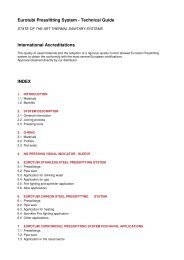corrosion of stainless steel - Damstahl
corrosion of stainless steel - Damstahl
corrosion of stainless steel - Damstahl
Create successful ePaper yourself
Turn your PDF publications into a flip-book with our unique Google optimized e-Paper software.
Stainless Steel and Corrosion<br />
Potential [mV SCE ]<br />
+475<br />
+200<br />
Drainage water (cleaned)<br />
Normal, aerated tap water<br />
Time<br />
Figure 6.20:<br />
Outline measurements <strong>of</strong> the <strong>corrosion</strong> potential <strong>of</strong> passive <strong>stainless</strong><br />
<strong>steel</strong> in standard tap water and purified waste water respectively.<br />
The measurements have been carried out over a period <strong>of</strong> more than<br />
14 days, and the <strong>corrosion</strong> potential for both is initially very low, but<br />
increases dramatically after about a week. Note that the end potential<br />
(due to bacterial activity) is far higher for <strong>stainless</strong> <strong>steel</strong> in purified<br />
waste water than in pure tap water.<br />
Waste water<br />
can be<br />
extremely<br />
corrosive to<br />
<strong>stainless</strong> <strong>steel</strong><br />
Acid-resistant<br />
<strong>steel</strong> is not<br />
always enough<br />
in sewage<br />
plants<br />
An excellent example <strong>of</strong> this is waste water, and <strong>stainless</strong> <strong>steel</strong> in sewage<br />
plants can behave very 'strangely'. The immediate reaction would be<br />
that the malodorous, impure intake at a sewage plant would be most<br />
problematic, but this is not the case. In the inlet, large concentrations <strong>of</strong><br />
extremely oxygen-hungry microorganisms can be found, and in practice<br />
these make the water almost oxygen-free. This gives a very low <strong>corrosion</strong><br />
potential which, in turn, gives an extremely good resistance to <strong>corrosion</strong><br />
for all types <strong>of</strong> <strong>stainless</strong> <strong>steel</strong>. It is thus more the rule than the exception<br />
that standard <strong>stainless</strong> <strong>steel</strong> in the 4301 category remains intact at the<br />
intake end.<br />
It is a completely different story at the pure outlet end (settling tanks,<br />
sand filters, etc.) where the water is almost as clean as tap water. Here<br />
the water behaves far more oxygenising than standard aerated tap water,<br />
and precisely because <strong>of</strong> the bacterial growth <strong>corrosion</strong> potentials <strong>of</strong><br />
more than 400 mV SCE<br />
can <strong>of</strong>ten be measured (un<strong>of</strong>ficial Danish record:<br />
+475 mV SCE<br />
!) equivalent to the level for <strong>stainless</strong> <strong>steel</strong> in diluted hydrogen<br />
peroxide. In these media even acid-resistant <strong>stainless</strong> <strong>steel</strong> in the<br />
4401/4404 category can be attacked by crevice <strong>corrosion</strong> which is why<br />
the welding specifications for sewage plants frequently contain a clause<br />
that states that neither pores nor crevices may be present. The behaviour<br />
<strong>of</strong> <strong>stainless</strong> <strong>steel</strong> in waste water is described in detail in [16].<br />
104<br />
RS for alle.indb 104<br />
9/29/2011 12:44:41 PM

















